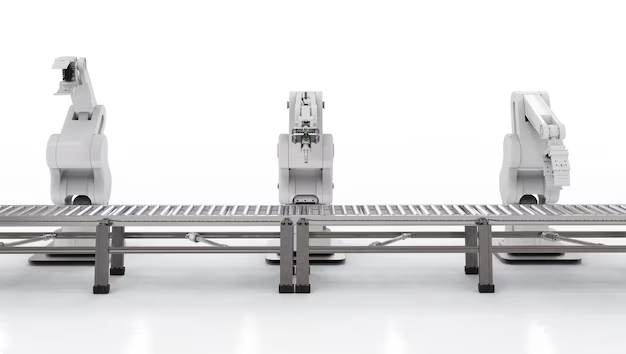Various industries depend on conveyor systems, which are designed to boost efficiency and optimize processes. In this article, we will look at nine strategies to enhance the efficiency of conveyor systems, including careful design and maintenance aspects.
By addressing key aspects, such as the integration of automation, variable speed controls, precise sorting systems, and employee training, businesses can unlock the maximum potential of their conveyor systems.
The integrative approach ensures continuous operations with reduced overheads and unhampered production amidst varying operation levels.
1.Optimized Design for Workflow Efficiency
The first step in efficiency involves designing a special conveyors system that matches the operations’ working mechanism. Aligning the conveyor layout accurately with operational requirements reduces extraneous movements, cuts down processing time, and boosts overall productivity.
By employing this strategic design, the company streamlines the flow of materials, optimizing the utilization of conveyor systems for better efficiency. It provides an interconnected framework within which all operations elements work towards improving organizational productivity.
Fine-tuning the design towards specific requirements opens up a framework for consistent and sustainable efficiency in conveyor systems.
2.Automation Integration

The importance of the strategic adoption of automation as an important component to boost efficiency cannot be understated. The modern-day integration of sensors, robotic arms, and programmable logic controllers facilitates a smooth operation. Companies can explore a wide range of industrial automation components to find the right tools and technologies to suit their specific conveyor system needs
This enhances automated material handling, which eliminates the need for power and accelerates material handling. The conveyor system develops a symbiotic connection with automation and increases efficacy, reliability, and precision during work.
In addition, businesses can use intelligent systems of conveyors or automatization of processes to create new space for efficiency. Advanced technology for smoother integration is the way forward for improved industrial processes as well as conveyors.
3.Variable Speed Controls
The key role of variable speed control in the performance of a conveyor rests in its adaptability to different operating situations. In addition, the feature facilitates making changes on the basis of the type of raw materials and potential shifts in the production specifications.
This technique helps to optimize the speed at each stage of the process, improving the overall outcome. Using a variable speed controller ensures that the conveyor system can change its moving velocities in accordance with the processing speeds, thus increasing effectiveness and flexibility.
This dynamic control mechanism, therefore, provides one of the vital means for a responsive industrial workflow dependent upon effective conveyors in diverse settings.
4.Accurate Sorting Systems

The development of accurate sorting systems using advanced technologies such as a bar code reader/scanner and computer vision improves accuracy in material handling. Efficiency reduces errors, cuts back on product damage, and guarantees prompt delivery at designated destinations.
Advanced sorting mechanisms combined with the dependable conveyor system ensure smooth material movement within the entire operation chain. These technologies are integrated into the organization as a form of investment that aims at increasing accuracy and error-free material handling.
The use of sorting systems leads to improved operational efficiency, minimal downtimes, and satisfied clients that companies gain through the process.
5.Regular Maintenance Protocols
Active maintenance policy forms the basis of proven conveyor efficiency. Hence, it must be critical to develop routine procedures like regular tests, lubrications, and tactically planned parts replacements.
The proactive measures act as protection against unanticipated breakdowns and contribute to improved reliability as well as steady output over time. Early detection of issues and the use of advanced lubrication prevents the premature destruction of the components.
Early replacement of broken parts also spares from breakdowns that would result from parts wearing out too fast ahead of time. The total maintenance approach helps to boost the reliability and smoothness of production processes.
6.Employee Training Programs

A competent and well-trained workforce is crucial to ensuring proper conveyor operation. Extensive training programs would enable the staff to effectively run, monitor, and even troubleshoot the conveyor system.
By taking such a preventive measure, incidents of human errors are greatly reduced, thus enhancing the efficiency and lifespan of the system. A competent operator will quickly be able to pinpoint potential problem areas in order to conduct routine maintenance or respond to an emergency shutdown.
It offers a smooth conveyance system and makes it possible to run without any interruption, thereby minimizing stoppages. Continuous training regimens as well-equipped operators with knowledge regarding emerging aspects of conveyor tech can be leveraged for enhanced output.
A competent and well-versed labor force is a key that will open up all opportunities for success inherent in a conveyor.
7.Energy-Efficient Practices
Including energy-efficient elements in the conveyor system reduces operational costs while working toward sustainability goals. They include the use of energy efficient motors, regenerative brakes, as well as recoverable energy.
The practices go beyond just economic benefits as they also reduce environmental impacts, and this makes the conveyor system suitable to the current sustainability standards. Embracing energy efficiency improves the entire system operation.
It also positions businesses as environmentally responsible entities, meeting the requirements of an increasingly eco-conscious market. This comprehensive approach fosters the balancing of operational effectiveness with environmental sustainability in an increasingly complex world of industry.
8.Flexibility in System Configuration
In a developing world of production, the design of the conveyor system should be flexible. Businesses are able to keep up with rapidly changing market requirements through the implementation of flexible modular features.
Therefore, this design philosophy means the conveyor system is always treated as a fluid element in the manufacturing process capable of adapting to changes dictated by production needs. A modern-day production conveyor system should be able to quickly and smoothly make changes to indicate a high degree of responsiveness.
Additionally, businesses can out-compete each other by designing systems with enough flexibility for them to bounce back swiftly when there are disruptions.
9.Smart Conveyor Technologies

The use of modern technologies, which are currently evolving, enhances efficiency. The combined use of IoT and AI can be applied through predictive maintenance, real-time monitoring of performance, and dynamic adjustment.
These smart conveyors can optimize routes on their own, locate issue areas, and reduce energy usage. Using this strategy, the conveyor system grows hand in hand with new technological innovations, ensuring an extremely productive and evergreen industrial setup.
The smart conveyors contribute to the continuous innovativeness strategy. It keeps companies at the frontier of efficiency and enables them to steer their way through the ever-changing territory of industrial processes.
Conclusion
Achieving optimum efficiencies in conveyor systems requires design optimization, smooth automation integration, and much more.
Companies should apply these multi-dimensional approaches tactfully to completely enjoy the benefits of their conveyor systems. The comprehensive approach views the conveyor systems as more than just logistics tools; it is considered as a living and evolving asset.
The modern industrial process is powered by several enhancements that are offered by conveyors, playing an essential role in the latest operational environment.

